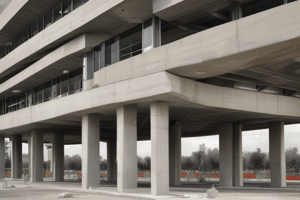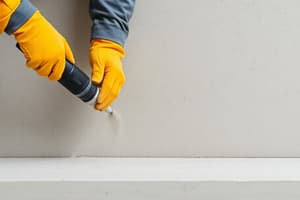Podcast
Questions and Answers
What is dusting?
What is dusting?
- The use of excessive water in the concrete mixture.
- Formation of loose powder resulting from disintegration of surface of hardened concrete. (correct)
- The process of finishing concrete floors.
- The application of a chemical floor hardener on concrete surfaces.
Why do concrete floors dust?
Why do concrete floors dust?
Concrete floors dust due to weak wearing surface caused by various factors such as poor finishing practices.
How to prevent dusting of concrete?
How to prevent dusting of concrete?
- Use concrete with the lowest water content and adequate slump. (correct)
- Sprinkle dry cement on the concrete surface.
- Delay bull floating operations.
- Perform finishing operations with excess water.
Inadequate ventilation in enclosed spaces can lead to dusting of concrete floors.
Inadequate ventilation in enclosed spaces can lead to dusting of concrete floors.
To repair dusting, one can sandblast, shot blast, or use a high-pressure washer to remove the weak _____ layer.
To repair dusting, one can sandblast, shot blast, or use a high-pressure washer to remove the weak _____ layer.
Flashcards are hidden until you start studying
Study Notes
Dusting Concrete Surfaces
- Dusting is the formation of loose powder resulting from the disintegration of the surface of hardened concrete.
- Characteristics of dusty surfaces: • Powder under any kind of traffic • Easily scratched with a nail or even by sweeping
Why Do Concrete Floors Dust?
- Concrete floors dust under traffic because the wearing surface is weak.
- Causes of weakness: • Finishing operations performed while bleed water is on the surface or before the concrete has finished bleeding • Poor finishing practices, such as broadcasting dry cement or sprinkling water on the surface during finishing • Floating and/or troweling operations following the condensation of moisture from warm humid air on cold concrete • Inadequate ventilation in enclosed spaces • Insufficient curing • Inadequate protection of freshly placed concrete from rain, snow, or drying winds • Allowing the concrete surface to freeze
How to Prevent Dusting
- Use concrete with the lowest water content and an adequate slump for placing and finishing
- Avoid using concrete with a high slump
- Use water-reducing admixtures to increase slump while maintaining a low water content
- Remove bleed water by dragging a garden hose across the surface
- Do not perform any finishing operations with water present on the surface or while the concrete continues to bleed
- Use air-entrained concrete to reduce excessive bleeding
- Modify mix proportions to reduce bleeding
- Accelerate the setting time to reduce bleeding
Special Cases
- In cold weather, use concrete with a moderate slump and an accelerating admixture
- Place concrete at a temperature exceeding 50°F [10°C]
- Use a trimable, compactible fill, such as a crusher-run material, over vapor retarders or non-absorptive subgrades prior to concrete placement
- Lightly dampen absorptive subgrades just prior to concrete placement to prevent high evaporation rates
Repairing Dusting
- Sandblast, shot blast, or use a high-pressure washer to remove the weak surface layer
- Apply a commercially available chemical floor hardener, such as sodium silicate (water glass) or metallic zinc or magnesium fluosilicate, in compliance with manufacturer's directions
Studying That Suits You
Use AI to generate personalized quizzes and flashcards to suit your learning preferences.




